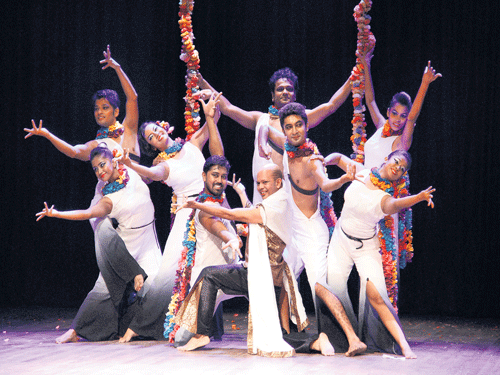
Rituranga is about the colours of the seasons. Among hundreds of Rabindranath Tagore’s compositions, the songs about changing of seasons have become a speciality. There are songs for every occasion — the dark clouds of monsoon, the pouring rain, the warm texture of autumn, the dry and freezing cold of winter and the joys of spring.
When you see Rituranga being performed on stage by dancers garbed not in a traditional Tagore dance-drama style, but in modern clothes, with contemporary dance movements set to Western symphony, you are taken aback at first. But you also realise that the essence of the poet’s lyrics and their meanings are not lost. You then sit back to enjoy the production and wonder about the creative mind behind the choreography. “It’s been called ‘Tagore in leotards’ by many in the media,” smiles Sudarshan Chakravorty, director and choreographer of Sapphire Creations Dance Company.
Dream run
It has been a long ride with many ups and downs for the company since its launch in 1992. While presenting Rituranga (one of its earliest productions) on Sapphire’s 23rd anniversary in Kolkata recently, Chakravorty has a reason to be a bit nostalgic. “When I started out with the idea of starting an ensemble of contemporary dance, people dissuaded me by saying, ‘it won’t work’. That Kolkata was rich in music and dance already and that some dance groups were giving a twist to existing dance formats were their arguments. But I wanted to do something different and plunged in anyway,” he says.
The boldness and conviction have paid off. Now, the dance troupe is invited to reputed dance festivals at home and abroad to present the creations on themes of contemporary relevance — like AIDS, sexuality and self-identification (as in Alien Flower), along with its own interpretations of existing scripts.
In fact, when Sapphire started to put up its shows, people were startled to see the dancers fit and seamlessly moving from Indian classical movements to yoga to acrobatics and to contemporary Western dance formats. The music could be a fusion of Tagore songs, Western jazz, even old Bollywood songs, but the idiom is always radical and experimental.
Over the years, Sapphire has also involved itself in dance workshops with eminent personalities and in nurturing newer dancers in the language of dance with an international flavour. The latest dance sensation and winner of India’s Got Talent, Manik Paul, who comes from a humble background, son of a tea-stall owner in Assam, was trained by Chakravorty.
Why is the dance company named ‘Sapphire’, you ask? “I was looking for a name that would reflect my ideas... something different... when I was conceptualising the dance company. I then read about this gemstone, blue and glowing. From ancient times the gem has been projected as a symbol of power and strength, but it also stands for kindness and wise judgement. I related to it immediately,” he says.
Chakravorty was at first trained in Bharatanatyam and Kathakali. “But I was always thinking of a third movement, a new style,” he says. Then, between 1988 and 1989, when he was introduced to Dancers’ Guild of (late) Manjusri Chaki Sircar, he knew he had found his métier.
founder of the experimental style called ‘Nava Nritya’, a combination of Indian classical, folk movements, yoga and martial arts. Chakravorty also gained skill in modern dance and jazz from the France-based dancer, Nana Gleason.
Another “mind-blowing” experience for him was watching Antim Adhyay, a production of Narendra Sharma’s Bhoomika group, which focussed on death as a complementary aspect of life, in Delhi in 1994. Imbibing modern techniques into Indian aesthetics, Sharma has been able to write a new language that is aesthetically pleasing and intellectually challenging, he feels. All these experiences and training have encouraged Chakravorty to find his own language, according to him.
But with so many kudos and honours under his belt, the dancer is still not happy. Because, he finds that even today, with many contemporary ensembles in different corners of the country, the language of contemporary dance is yet to reach the general audience.
It is partly due to the apathy of the educational institutes of performing art and even the dancer community itself. “There’s not a single course on contemporary dance in any university in India,” he observes. “You can’t evaluate modern dance forms according to the rules of Natya Shastra, even though body movements are the common elements in both. It’s a different way of expression altogether,” he adds.
Need for forums
On the other hand, he points out, there is hardly any communication among those practising contemporary dance. “We must establish a link and exchange ideas among our own fraternity; we must know what experimentations are going on so that the movement itself gets an impetus.” Also, according to him, the current dance scenario is stagnating. “We have made gods out of the older generation of gurus and following in their footsteps instead of trying to do something new to attract newer generations.”
Focussing on the digital-age sensibilities, he observes, “We have to look at mixed media, the new options available today, and accept that the world has moved on. Our choreography and themes have to keep pace, otherwise, the young generation will lose interest. Even the dancers will feel discouraged because employment opportunities are limited. If the shows don’t run, it will be difficult for the dancers to survive.”